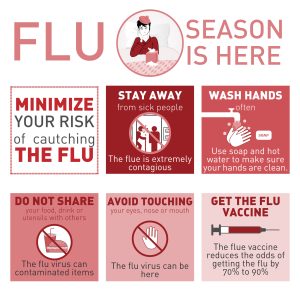As flu and cold season loom closer, it’s time to strategize for increased foot traffic and revenue. Healthcare professionals understand the importance of early preparation. You’ve got this! Utilizing targeted digital advertising is your ace in the hole for community engagement and attracting visitors to your medical facility. Employ targeted digital advertising as your winning move to captivate your target audience, drawing them in (and hopefully keeping the sniffles at bay). Here’s the playbook for success.
The Importance of Digital Advertising in Healthcare
Digital advertising has revolutionized how healthcare facilities connect with their communities. With the ability to target specific demographics and geographies, healthcare providers can reach potential patients more effectively and efficiently. In fact, studies have shown that digital advertising in healthcare can increase patient acquisition by up to 30%. This is a significant boost for your facility’s bottom line.
Digital Advertising Strategies for Healthcare Facilities
1. Social Media Advertising
Social media advertising is an essential component of a robust digital marketing strategy, especially during flu season when healthcare needs surge. Platforms like Facebook, Instagram, Twitter (X), LinkedIn, and even TikTok offer diverse opportunities to connect with various segments of your community. On Facebook and Instagram, for instance, you can create visually engaging ads highlighting your facility’s flu-related services, such as vaccination clinics or telemedicine consultations. Twitter can be used for timely updates and health tips, while LinkedIn can target professional audiences, offering content on workplace wellness during flu season. TikTok, with its short-form video content, can be an innovative way to engage younger demographics with flu prevention tips and behind-the-scenes looks at your healthcare facility.
Different strategies can be employed to maximize the effectiveness of these platforms. For example, leveraging Facebook and Instagram’s advanced targeting options allows you to reach specific demographics such as families with young children or elderly individuals who are more vulnerable to the flu. Employing LinkedIn for sponsored content can position your hospital as a leader in community health, while Twitter can serve as a platform for quick, real-time engagement with your audience. On TikTok, creating short, informative, and entertaining videos can capture the attention of a younger audience, encouraging them to take proactive steps in flu prevention. By combining these platforms with a well-thought-out content strategy, your facility can effectively raise awareness, engage with the community, and ultimately drive more patient traffic during flu season.
2. Pay-per-Click Campaigns (PPC)
When it comes to reaching potential patients online, investing in Pay-per-Click (PPC) campaigns is a smart move. Google Ads, in particular, can be super effective for targeting folks actively looking for healthcare services. By setting up targeted campaigns using keywords related to flu and cold symptoms, and including your location, you can make sure that your ads are seen by the people who need them the most.
PPC campaigns through Google Ads are a great way to connect with potential patients searching for healthcare services online. By using targeted keywords related to flu and cold symptoms, along with your location, you can maximize the impact of your ad campaigns. This approach can help ensure your ads get in front of the right audience, and ultimately attract the patients who need your services.
If you’re looking to reach more patients online, consider investing in Google Ads for your healthcare practice. Setting up targeted campaigns with the right keywords related to flu and cold symptoms, combined with your location, can help increase the visibility of your ads to potential patients actively seeking healthcare services. This strategic approach can make a real difference in getting your services in front of those who need them.
3. Content Marketing: Health and Wellness Blogs and Articles
Healthcare facilities can benefit from creating health and wellness blogs and articles because it allows them to showcase their expertise and provide valuable information to their audience. For example, a healthcare facility could publish a blog post titled “5 Key Benefits of Daily Exercise for Heart Health” to educate its audience about the importance of physical activity in maintaining a healthy heart. This type of content not only positions the healthcare facility as a trusted source of health information, but also helps build strong relationships with current and potential patients.
Furthermore, by writing about health and wellness topics, healthcare facilities can also address common concerns and questions that their audience may have. For instance, they could create an article titled “Understanding the Link Between Nutrition and Immune System Health” to explain the role of diet in supporting the immune system. Providing such informative content can help healthcare facilities increase engagement with their audience and convert them into loyal patients.
In addition, creating health and wellness blogs and articles can improve a healthcare facility’s search engine optimization (SEO) efforts. Blog posts and articles targeting relevant keywords and topics can drive organic traffic to the healthcare facility’s website, increasing its online visibility and attracting potential patients actively seeking health-related information. Healthcare facility marketers can therefore leverage this content to enhance their digital marketing strategy and expand their reach within their target market.
4. Geofencing Marketing
Not to brag, but geofencing marketing is Propellant Media’s bread and butter. We love geofencing because it allows us to send highly targeted and personalized ads to potential patients based on location. By establishing virtual boundaries encompassing a medical facility, marketers can strategically deliver tailored advertisements and promotions to individuals entering the specified region. This innovative approach enables hospitals to effectively pinpoint and engage with individuals near their establishment, potentially requiring urgent healthcare services.
A hospital can establish a geofence around a particular neighborhood or shopping center. When people enter this area, the hospital can use targeted ads to promote services like health check-ups, flu vaccinations, or specialized treatments. This type of marketing can be cost-effective in reaching nearby potential patients and increasing the chances of turning them into actual patients.
5. Search Engine Marketing (SEM)
Search Engine Marketing (SEM) is a crucial digital marketing strategy for healthcare marketers. It focuses on promoting websites and increasing their visibility in search engine results pages. This can be accomplished through paid advertising methods, such as pay-per-click (PPC) campaigns, allowing healthcare organizations to reach potential patients actively searching for relevant services.

However, SEM requires constant monitoring and optimization to ensure the best return on investment. Healthcare marketers need to have in-depth knowledge of keyword research and bidding strategies to be successful. Additionally, it’s important to continuously analyze and adjust campaigns based on performance data to reach the right target audience and maximize conversions. By effectively utilizing SEM, healthcare organizations can increase their online presence and attract more potential patients to their websites.
6. Local SEO and Google My Business Optimization
During flu season, many people use their phones or computers to search for nearby healthcare facilities, making it essential for healthcare organizations to have a strong presence in local searches. This can be achieved through Local Search Engine Optimization (SEO) strategies and optimizing the Google My Business (GMB) listing. Local SEO involves optimizing websites and online content with location-specific keywords and information, such as the city or neighborhood name. Some tips for local SEO include including the location in website titles, meta descriptions, and page content, registering with online directories and local business listings, and encouraging customers to leave reviews on the Google My Business listing.
Google My Business (GMB) is a free tool provided by Google that allows businesses to manage their online presence across Google Search and Maps. By claiming and optimizing the GMB listing, businesses can provide important information, such as hours of operation, contact information, and services offered. This helps potential patients find the organization more easily, and improves the chances of showing up in the coveted “local pack” at the top of search results. Positive online reviews can significantly influence a person’s decision to choose a healthcare organization. I suggest you encourage satisfied patients to leave reviews on the GMB listing or other review sites, such as Yelp or Healthgrades.
7. Video Advertising
Video advertising has become increasingly popular in the digital marketing world, and for good reason. With the rise of platforms like YouTube and social media networks incorporating video content into their algorithms, healthcare organizations have a prime opportunity to reach their target audience through video ads.
For example, a hospital can create a video ad that showcases its state-of-the-art facilities and compassionate staff, while also providing important information about its services. By targeting specific keywords and demographics, hospitals and physicians’ offices can guarantee that their video ads are shown to the right audience.
However, it’s important for healthcare marketers to carefully consider the message and tone of their video ads. They must strike a balance between being informative and persuasive, without coming across as too promotional or insensitive to sensitive health topics.
Overall, incorporating video advertising into a comprehensive digital marketing strategy can greatly benefit healthcare facilities by increasing brand awareness, promoting trust and reputation, and ultimately driving patient engagement and acquisition. Video ads allow for a more engaging and visually appealing way to communicate with potential patients, making them more likely to remember the message and take action.
8. Native and Programmatic Display Advertising
Native advertising effortlessly blends in with its surroundings, making it less intrusive and more enjoyable for users. Adapting to the format and style of the platform increases the likelihood of native ads catching people’s attention as compared to traditional display ads. This is particularly advantageous for healthcare practices aiming to engage potential patients. For instance, healthcare facilities could utilize native advertising to produce informative and captivating articles on relevant healthcare topics, such as preventive care tips or new treatment options, thereby establishing themselves as reliable sources of information and maintaining visibility for individuals researching healthcare options by publishing sponsored content on health and wellness websites or social media platforms.

Programmatic display advertising also leverages automated processes to efficiently purchase and place ads across diverse websites. This approach allows precise targeting based on user behavior and interests, thereby optimizing ad delivery for maximum impact. For instance, a hospital could use programmatic display advertising to reach specific demographics based on factors such as age, location, and online behavior. To effectively nurture leads and drive engagement with personalized messages that promote health screenings or specialized medical services, the hospital can display targeted ads on relevant websites visited by the desired audience. This approach will ultimately lead to improved results and return on investment.
9. Email Marketing
Email marketing remains a powerful tool for hospitals looking to increase engagement and awareness. With an effective email marketing strategy, hospitals can deliver targeted messages to segmented audiences, including information on flu prevention, vaccination reminders, and updates on flu-related services. By leveraging email marketing, hospitals can foster community and trust, while providing valuable health resources to patients and the community.
An important component of a hospital’s email marketing strategy during flu season is to ensure that the content is informative and relevant. Hospitals can create engaging content around flu prevention tips, the importance of vaccination, and updates on the availability of flu shots. Providing valuable and actionable information can position hospitals as trusted sources of healthcare advice. Additionally, personalized content tailored to different audience segments, such as elderly patients or parents with young children, can further enhance the effectiveness of email marketing campaigns during flu season.
Interested in learning more about how to get the most out of your email marketing?
Success Stories from the Healthcare Industry
Over the years, dozens of healthcare organizations have entrusted Propellant Media to innovate their digital marketing strategies and boost their patient conversion rate to increase revenue. From hospitals and urgent care to medical practices and pharmacies, our team has successfully helped our clients stay ahead in the constantly evolving healthcare industry. In this section, we’ll examine some of these success stories and learn how they achieved their goals.
Nurse Fulfillment in a Hospital
A large hospital system on the West Coast aimed to recruit nurses, including CNAs, Traveling Nurses, and RNs, by leveraging a comprehensive 12-month marketing strategy from Propellant Media. This included geofencing marketing around competitor hospitals, site retargeting, pre-roll video, OTT/CTV advertising, and a new approach to Facebook/Instagram ads using geofencing audiences. The campaign generated 1,466 application landing page visits, and over 400K video views, and maintained an average conversion cost of $33 on Facebook/Instagram and $173 on Google Ads. The strategy effectively filled nursing positions, demonstrating the success of the omnichannel approach.
An Optometry Clinic Needs Lead Generation
An optometry clinic faced heavy competition and sought to enhance its marketing strategy by implementing geofencing and programmatic display solutions. Propellant Media developed a comprehensive approach that included site retargeting, keyword contextual/search targeting, and addressable geofencing to reach their core audience. By optimizing Google Ads and managing the entire omnichannel strategy, they drove over 250 leads and 500 phone calls per month to the practice. The campaign maintained a cost per lead of $63, and the programmatic efforts resulted in a click-through rate of 0.12%, leading to 2,900 clicks and 70-90 walk-ins monthly. The ongoing strategy effectively expanded the clinic’s reach across all marketing funnels.
While these case studies are not specifically dedicated to flu season marketing, they speak to the effectiveness of targeted and timely campaigns for healthcare practices.
Why Partner with Propellant Media?
 When it comes to digital advertising, partnering with a specialized agency can make all the difference. Propellant Media is an excellent choice for your digital advertising needs. Our team of experts understands the healthcare industry and knows how to create targeted campaigns that drive results.
When it comes to digital advertising, partnering with a specialized agency can make all the difference. Propellant Media is an excellent choice for your digital advertising needs. Our team of experts understands the healthcare industry and knows how to create targeted campaigns that drive results.
Propellant Media is particularly adept at leveraging digital marketing strategies to reach your target audience in the healthcare industry. With a keen understanding of the unique challenges and opportunities within healthcare marketing, our experienced team can craft tailored solutions that effectively engage potential patients and drive growth for your practice or organization. Whether it’s increasing brand awareness, driving patient appointments, or promoting specific services, Propellant Media is dedicated to delivering impactful and measurable results for your healthcare marketing needs.
Conclusion
In conclusion, leveraging a strategic digital marketing approach during flu season is essential for hospitals to increase patient traffic and provide timely care. By utilizing geofencing marketing, programmatic display ads, social media campaigns, and search engine marketing, hospitals can effectively target high-risk populations and those actively seeking flu-related care. These tactics not only drive patient visits but also enhance community awareness and trust in the hospital’s services. A well-executed digital marketing strategy ensures hospitals can meet the increased demand during flu season while positioning themselves as the go-to healthcare provider.
If your hospital is looking to boost traffic and effectively manage patient care during flu season, Propellant Media is here to help. Our team of experts specializes in creating tailored digital marketing strategies that deliver results. Let us help you reach the right audience at the right time, and make certain your hospital stands out during this critical period. Schedule your free consultation today!


